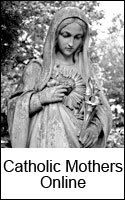every time you go to bible study.
This year we are studying the Book of Revelation. Last year, it was the Gospel of St. Matthew and I posted my notes each week. Not gonna happen this year because I don't have the time and I don't think I'm learning as much as last year. But, then, it's only the first week. Guess we were spoiled with Father Echert's lectures last year and now we have to watch a priest on a DVD instead.
But I will post the interesting points or the nuggets I learned. There is way more symbolism and reference to OT books than I can address. I do find it incredible that the bible is so inter-woven...God really saw the big picture when He wrote it :)
Here are the Chapter 1 points I learned:
* The chapter opens with a Benediction, linking the book to the Mass from the outset.
* Seven is the number of completeness, so the seven churches mentioned refer to St. John addressing the entire Church, not just these churches individually. The priest on the DVD said it was the number of perfection of the covenant.
* In one of our study questions, we were asked whose voice is heard speaking like a trumpet to St. John (v. 10-11). Some answered Jesus and some answered an angel. I wrote that they saw Jesus, who appeared as "one like the son of Man," but that they heard the Angel of God. In looking at Haydock's commentary, it says this voice --- A great voice, as of a trumpet. To signify the importance of things to be revealed. (Witham) --- Voice, &c. This was most likely St. John the Baptist, who calls himself the voice of one crying in the desert, and who in Malachias is called the Angel of the Lord, as he is also styled in the first verse of this chapter. Of course, I think my fellow students thought I was a nut to say it was St. John the Baptist, but having used Haydock's commentary for my other bible studies, I have to say I tend to agree with Haydock because St. John the Baptist has always been the precursor to Jesus, and since this book is so full of symbolism, it only makes sense that this is St. John the Baptist.
* Another theophany takes places, just like in the Transfiguration and when God appeared on Mt. Sinai. Full of the same symbolism.
* In verses 13-16, it mentions what the one in the midst of the lampstands, "one like a son of man," was wearing: a long white robe and with a golden girdle round his breast. The clothing is symbolic of the priesthood, but it is what a priest wears AFTER the sacrifice has taken place. Very cool.
* The two-edged sword represents the Word of God and is the only weapon He is carrying. It also portrays Christ as a judge, whose Word distinguishes good from evil and who distributes rewards and punishments.
There is so much symbolism, much of it coming directly from books of the OT, that it is mind-boggling. I'm trying to get some Navarre commentaries on Exodus, Daniel and Isaiah, just to tap into some of the OT references St. John has woven into Revelation.
WDTPRS – Baptism of the Lord (Double Dipping)
5 hours ago



















1 comment:
I knew the book was essentially a vision of the Mass and its eternal significance but I never knew it began with Benediction. Must go back and have a look at that.
There's so much in Revelation and it seems so complete.
And of course I am still working towards that WhiteStone Name I hope to receive one day. LOL.
Post a Comment